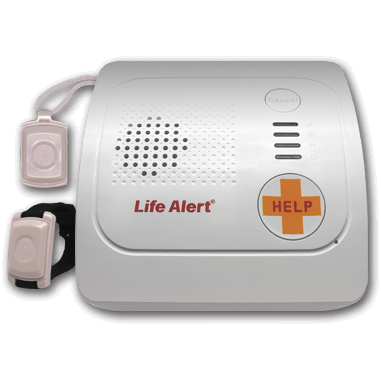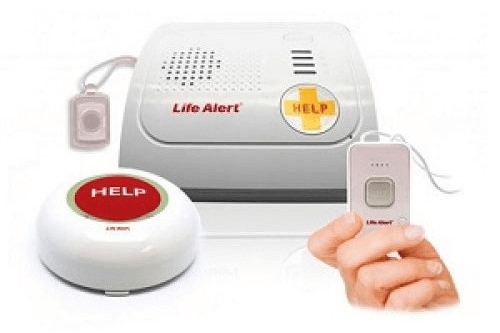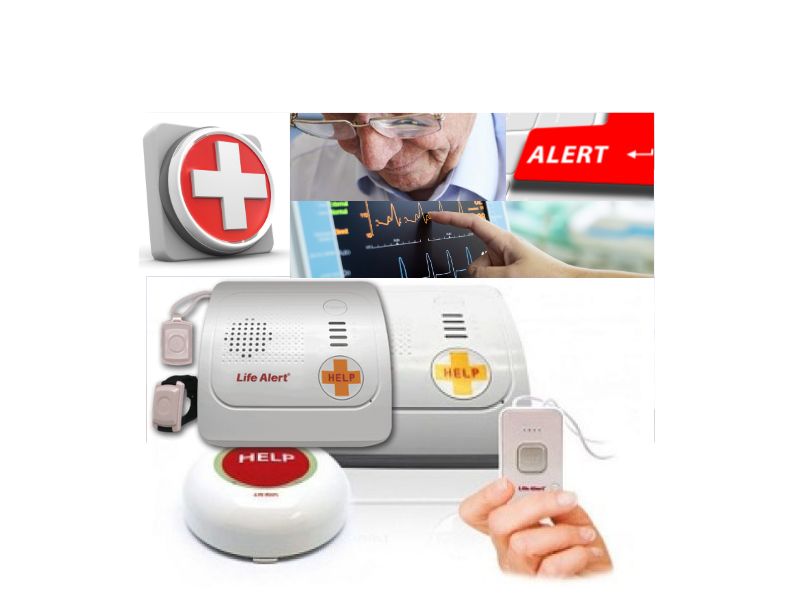Life Alert vs Alert 1
Medical alert systems are designed to signal the presence of a hazard requiring urgent attention and to summon emergency medical personnel. These systems are typically composed of a wearable medical alert device, like a pendant or wristband, and a base unit connected to a monitoring center via a cellular or landline connection.


4.6
Starts at $49/month
Life Alert


4.7
Starts at $19.95/month
Alert 1
Brio House is an independent review site. We may earn money when you click links inside our site.
Medical alert systems are designed to signal the presence of a hazard requiring urgent attention and to summon emergency medical personnel. These systems are typically composed of a wearable medical alert device, like a pendant or wristband, and a base unit connected to a monitoring center via a cellular or landline connection.
When the user presses the button on their medical alert device, the signal is sent to the monitoring center, where trained operators can communicate with the user and dispatch emergency services if necessary. Some systems also include automatic fall detection technology, which can automatically send an alert if the user falls and can’t press the button.
These systems are particularly beneficial for older adults who live alone, as they provide a lifeline to medical assistance in case of emergencies. They also offer peace of mind to family members, knowing that their loved ones can get help even when they’re not around.
Importance of Medical Alert Systems for Older Adults
Medical alert systems play a crucial role in ensuring the safety and independence of older adults, particularly those living alone or with chronic medical conditions. These systems provide a simple and efficient way for seniors to call for help in the event of an emergency, such as a fall or medical issue.
Falls are a significant concern for older adults. According to the Centers for Disease Control and Prevention, one in four older adults falls each year, and falls are the leading cause of both fatal and nonfatal injuries among seniors. Medical alert systems with automatic fall detection can be a lifesaver in such situations, as they can automatically alert the monitoring center even if the user is unable to press the button.
Moreover, these systems can provide peace of mind to both users and their loved ones, knowing that help is just a button press away. They also allow older adults to maintain their independence, which can contribute to their overall well-being.
The Medical Alert Industry: A Brief Overview
The medical alert industry is a rapidly growing sector, with the market size projected to reach USD 11.1 billion by 2026. This growth is largely driven by the increasing geriatric population and the high level of health literacy among older people.
The industry is characterized by a variety of medical alert systems and devices, including home-based systems, mobile medical alert systems, and automatic fall detection devices. These systems are designed to provide immediate assistance in the event of a medical emergency, such as a fall or health crisis.
The medical alert industry is also witnessing significant technological advancements, with the integration of Internet of Things (IoT) and artificial intelligence (AI) in medical alert systems. These technologies enable features like automatic fall detection, location tracking, and predictive analytics, enhancing the efficiency and effectiveness of these systems.
The medical alert industry continues to evolve and innovate, offering more sophisticated and reliable solutions for older adults and those with medical conditions.
Life Alert and ALERT 1: An Overview


Life Alert: A Detailed Review

Life Alert is a renowned medical alert system company that has been providing emergency response services since 1987. The company is best known for its “Help, I’ve fallen, and I can’t get up!” advertisement, which has become a part of popular culture.
Life Alert offers a range of medical alert devices designed to provide immediate assistance in the event of a medical, fall, shower, and home invasion emergencies. Their systems include a base unit and a waterproof pendant or wristband, with a battery life of up to 10 years.
Life Alert systems are connected to the company’s monitoring centers, which operate 24/7 and are staffed by trained emergency dispatchers. The company claims that their service saves a life from a potential catastrophe every 11 minutes.
Pros and Cons of Life Alert
Life Alert is a well-known name in the medical alert industry, offering a range of medical alert devices designed to provide peace of mind and emergency assistance to its users. However, like any product, it has its strengths and weaknesses.
PROS
CONS
Alert 1: A Detailed Review

Alert1 is another leading provider in the medical alert industry, offering a variety of medical alert systems to meet the needs of older adults and those with medical conditions. The company’s mission is to promote independence and safety among seniors.
Alert1 offers both home and on-the-go systems, all of which connect users to a US-based monitoring center in the event of an emergency. Their devices include a home fall detection system, a mobile medical alert system with GPS tracking, and a medical alert pendant.
One of the key features of Alert1 is its flexibility. There are no long-term contracts, and the company offers a 30-day money-back guarantee. Additionally, Alert1 systems are compatible with a landline or cellular network, allowing users to choose the best option for their needs.
Pros and Cons of Alert 1
Alert 1 is another prominent player in the medical alert industry, offering a variety of medical alert systems to cater to different user needs. Here are some of the pros and cons of choosing Alert 1.
PROS
CONS
comparing Life Alert vs ALERT 1
| Company | Device Variety | Fall Detection | Range | GPS | Pricing | User Experience |
|---|---|---|---|---|---|---|
 |
View Packages | No | Between 800′ and 1000′ | Yes | Starts at $49/month | Responsive emergency services |
 |
View Packages | Yes | Between 400′ and 600′ | Yes | Starts at $19.95/month | Affordability of the systems |
Feature Comparison: Life Alert vs alert 1
Equipment and Devices
- Both Life Alert and Alert 1 offer water-resistant wearable devices. Life Alert offers both pendant and wristband options, while Alert1 only offers a pendant.
- Both companies provide 2-way voice communication through an in-home base unit or a mobile pendant/wrist button.
- The range from the in-home base unit to the landline service for Life Alert is between 800′ and 1000′, while for Alert1 it’s up to 400′ for the fall detection system and up to 600′ for the entry-level system without fall detection.
Fall Detection Technology
- Fall detection technology is an important feature of medical alert systems. Life Alert does not offer this feature, while Alert1 does.
- This technology can be especially beneficial for older adults who are at risk of falls, as it can automatically detect a fall and alert emergency services, even if the user is unable to press the emergency button.
GPS Tracking and Location Services
- Both Life Alert and Alert 1 offer GPS tracking and location services. This feature is included in their mobile devices and is particularly useful for older adults who are still active and spend time outside their homes.
- It allows the monitoring center to locate the user in case of an emergency, which can be crucial in situations where the user is unable to communicate their location.
Costs and Fees
- Life Alert and Alert 1 differ significantly in terms of costs and fees. Life Alert’s monthly monitoring prices start at $49.95 per month for basic in-home landline-based service, which is notably higher than the $19.95 monthly fee charged by Alert1 for its home medical alert system when subscribers pay for 12 months of service in advance.
- Alert1 subscribers who prefer to pay on a semiannual basis pay $22.95 for basic service and $25.95 when paid quarterly. The monthly cost of Alert1’s premium package, On-the-Go + Home Fall Detection, is $52.95 when paid annually.
- By comparison, Life Alert’s most expensive monthly package is $68, and subscribers must pay between $98 and $198 in up-front equipment costs.
Contract Terms and Conditions
- The contract terms and conditions of Life Alert and Alert 1 are quite different. Life Alert requires users to sign a three-year contract, which can only be cancelled if the subscriber passes away, is placed in a nursing facility, or needs 24/7 care.
- On the other hand, Alert1 offers month-to-month contracts up to 12 months, providing more flexibility to its users. This can be a significant advantage for users who are unsure about their long-term needs or who prefer not to be locked into a long-term contract.
Life Alert: User Reviews and Better Business Bureau Rating
Life Alert has mixed user reviews. Some users praise the company for its reliable service and responsive emergency services. However, others have criticized the company for its high costs and the requirement for a three-year contract. As of the latest check, Life Alert has a B- rating from the Better Business Bureau.
Alert 1: User Reviews and Better Business Bureau Rating
Alert 1 also has mixed reviews from users. Some appreciate the affordability of the systems and the flexibility of no long-term contracts. However, others have reported issues with customer service and the reliability of the devices. Unfortunately, the latest Better Business Bureau rating for Alert 1 could not be retrieved due to a technical issue on the BBB website.

Which is the Right Medical Alert System?
Choosing the right medical alert system depends on individual needs, preferences, and budget. Life Alert may be a goodchoice for those who value a well-known brand with its own emergency responders and don’t mind committing to a three-year contract. On the other hand, Alert 1 might be more suitable for those seeking more affordable options and flexibility with no long-term contracts.
It’s important to consider factors such as the range of device options, the reliability of the emergency services, the presence of fall detection technology, and the quality of customer service when making a decision. It’s also recommended to read user reviews and check the Better Business Bureau ratings for both companies.
Remember, the goal is to choose a medical alert system that provides peace of mind and ensures that help will be available when it’s most needed.
Other Popular Medical Alert Systems: Brief Overview
Medical Guardian
Medical Guardian offers a variety of medical alert systems, including in-home systems and mobile systems. It stands out for its premium features, such as optional add-ons to customize the system to specific needs. However, these extras come at an additional cost, which can make the system more expensive.
Bay Alarm Medical
Bay Alarm Medical is known for its affordability and fast response times. It offers both in-home and on-the-go systems, with the option to bundle both for a discounted rate. However, it lacks some of the advanced features found in other systems.
MobileHelp
MobileHelp offers a range of options for both home-based and active users. It stands out for its fast response times and competitive pricing. It also offers a telehealth service, allowing users to virtually visit a board-certified doctor without an appointment.
LifeFone
LifeFone offers a variety of systems and stands out for its customer-friendly policies, including a price-lock guarantee and a lifetime warranty for manufacturer defects. It also offers a 30-day risk-free trial.
ADT Health
ADT Health offers straightforward devices and pricing, with no hidden costs or extra fees. It also offers a price-lock guarantee and free replacement batteries. However, it offers fewer options compared to other providers.
GetSafe
GetSafe offers a unique approach to medical alert systems, with no wearable devices. Instead, users place different types of life alert devices around the home, which can be activated by pulling a cord, pushing a button, or saying “Call 911”.
Conclusion: Choosing the Best Medical Alert System
Choosing the best medical alert system for you or your loved one requires you to think about the user’s activity level, budget, home size, and health risks. The best medical alert systems are flexible enough to fit most lifestyles. Whatever alert system you choose, it needs to be comfortable, easy to use, and convenient enough to keep nearby 24/7.
Factors to Consider
- In-home vs. mobile medical alert system: An in-home system is best for older adults who don’t venture outside much. A mobile system is typically used by older adults who do go outside by themselves. Consider both an in-home and a mobile medical alert system for spouses or partners who have different levels of mobility.
- Landline or cellular connection: Landline systems are always the most affordable medical alerts. They’re also more reliable in areas of the country that get poor cellular coverage. Cellular systems are easier to set up. The choice really comes down to available infrastructure and personal preference.
- Signal range: The wearable help buttons must be close to the base station to communicate with it. If you have a large home, it’s important to get a system that you can use in every room.
- Extra buttons and accessories: Consider buying extra buttons and accessories for an in-home system if your home is quite large or there’s a possibility you’ll forget to wear the pendant.
- Automatic fall detection: Automatic fall detection is available as an add-on for most in-home and mobile medical alert devices. It typically costs an extra $10 per month. This technology is best for people who spend time alone and are at an increased risk of falls due to their medical history, including medication side effects.
- Panic button battery replacements: Wearable help buttons contain batteries that last at least three years. Some companies track the button’s battery life and send you a replacement for free. Others tell you it’s time to buy a new button and charge for the replacement.
- Extra caregiver features: Some companies provide a smartphone app that keeps loved ones up-to-date on all emergency calls, battery alerts, first movements of the day, and more. These apps are either included in the plan or available for an extra monthly fee.
- Costs: The cost of a medical alert system may limit your selection. Expect to pay out of pocket, since most Medicare plans don’t cover medical alert devices. Decide what your monthly budget is and how much you’re willing to spend upfront on equipment and activation fees.

Final Thoughts
Once you’ve chosen a medical alert system, set it up and test it. Every medical alert company encourages this—you won’t get fined for a false alarm. Once the monitor connects, tell them you’re testing the equipment. They’ll confirm your address and disconnect. No sweat!
Evaluate the following when testing your equipment:
- Audio quality and volume
- Answer speed
- Monitor clarity and friendliness
- Ease of voice activation (if applicable)
- Signal range (some systems have a separate range test you can do)
If you’re unhappy with any of the above, let the company know. You can either get a refund or ask for a new piece of equipment. It’s better to work out these kinks before an emergency. Plus, testing the equipment builds confidence and makes it easier to use when it counts.
FAQs on Life Alert and Alert 1
What is Life Alert?
Life Alert is a medical alert system designed to provide immediate assistance in the event of a medical, fall, shower, and home invasion emergencies. The system works by pressing the emergency button on the wearable device, which then sends a signal to the Life Alert Monitoring Center. A dispatcher from the center will then communicate with the user through the base unit’s two-way voice communication feature. If the user is unable to respond, the dispatcher will send help immediately.
How does Life Alert work?
Life Alert works through a two-component system: a small, waterproof pendant or wristband button and a base unit. When the button is pressed, it sends a signal to the base unit, which then communicates with the Life Alert Monitoring Center. The center’s dispatchers will then assess the situation and send the appropriate help if needed.
What is Alert 1?
Alert 1 is another medical alert system that provides 24/7 emergency response at the press of a button. It offers a range of products, including home-based systems, mobile systems, and fall detection devices. Alert 1’s services also include a Care Circle feature, which allows users to involve family members and friends in their care.
How does Alert 1 work?
Alert 1 works similarly to Life Alert. Users wear a pendant or wristband with a help button. When pressed, the button sends a signal to the Alert 1 Response Center, where trained operators respond, assess the situation, and send help if needed. The system requires a landline for the home-based system, but the mobile system uses cellular networks for communication.
How do Life Alert and Alert 1 compare?
Both Life Alert and Alert 1 offer 24/7 monitoring and immediate response to emergencies. However, they differ in terms of pricing and contract requirements. Life Alert requires a three-year contract and does not disclose pricing information on its website, while Alert 1 offers monthly, quarterly, semi-annual, and annual plans with no long-term contract required. Alert 1 also offers a price-lock guarantee, meaning the monthly rate will not increase over time.
